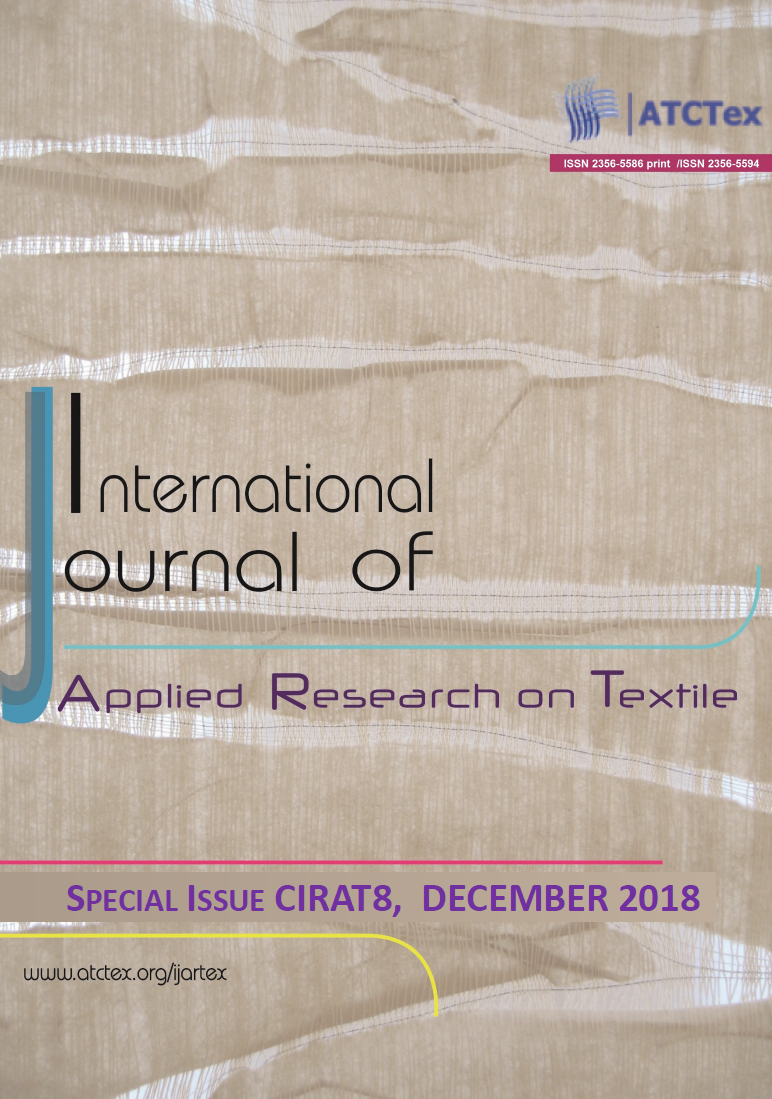Preface
S., BENLTOUFA1. W., MILED2. M., BEN TICHA3. S., MSAHLI2.
Corresponding author:MILED Wafa E-mail:w.miled@yahoo.fr
1Laboratory of Thermal and Energetic Systems Studies (LESTE), National Engineering School of Monastir, University of Monastir, Monastir 5000, Tunisia
2Laboratory of Textile Engineering, University of Monastir, Ksar Hellal 5070, Tunisia
3Université de Monastir, Faculté des Sciences, Unité Chimie Appliquée – Environnement UR13ES63, Monastir 5000, Tunisia
Abstract:
ABOUT THIS SPECIAL ISSUE: CIRAT is a scientific meeting organized by the Textile Engineering Laboratory every two years. This conference provides an international open forum for researchers from academic and industrial fields to present their original work and exchange ideas and information.
The eighth edition had brought worldwide researchers and practitioners to share and discuss the latest scientific concepts and technological developments in textile. It also intends to promote sharing ideas and emerging technologies, as well as to foster research and development collaborations amongst academia, research institutions .
INTERFACING QUALITY ASSESSMENT TOOL BEFORE AND AFTER WASHING
R., TILOUCHE1. R., BEN ABDJELIL 2. M., BEN HASSEN3.
Corresponding author:TILOUCHE Rahma E-mail:tiloucherahma86@yahoo.fr
1Laboratory of Textile Engineering, University of Monastir, Tunisia
2Textile Material and Processes Research Unit, University of Monastir, Tunisia
3Industrial Engineering Department: University of Taibah; Saudi Arabia
Abstract:
Interfacing is an inner construction material that lies between layers of fabric. Its primary purpose is to give stability, shape, and reinforcement to the fashion fabric. Thereby, it plays an extremely important role in the overall success of garments. The main goal of this paper it is to develop a quality assessment tool for interfacing in order to prevent quality issues during production. Four types of interfacing where tested on thirty-seven different waistbands made from denim fabric. Tests are carried out using three different machines, namely iron, fusing machine and fusing press. The samples were mainly evaluated according to the following criteria: aspect, adherence, elasticity, tearing and wrinkling. For all samples, each criterion is scored on a 4-point scale, ranging from 0=mediocre to 3=excellent. Then, a global interfacing acceptability level (GIAL) is calculated based on the specified criteria. According to this parameter, the interfacing can be accepted if its quality is judged as good or excellent. Otherwise, it is rejected and its quality is judged as mediocre..
PROPERTIES OF 2-LAYERED AND 3-LAYERED LAMINATED SAILING GARMENTS
S., KARA1. S., YEŞİLPINAR1.
Corresponding author:kara sukran E-mail:sukran.kara@deu.edu.tr
1Textile Engineering Department, Dokuz Eylul University, Turkey
Abstract:
Sailing is an active sports type and sailing garments should exhibit several functional and performance properties. Protective sailing garments are expected to protect the wearer against harsh environmental conditions (wind, rain, sea water, sunrays), maintain the comfort and sustain the mobility. To provide all these requirements, sailing garments are manufactured from 2-layered or 3-layered coated or laminated fabrics. After market search, it was inferred that laminated fabrics were preferred more by the sailing garment manufacturers. But there is not enough literature in efficient quality and quantity to understand the properties of commercial sailing garments. Therefore, in this study, commercial sailing garments with polyamide (PA) and polyester (PET) base fabrics and polyurethane (PU) and polytetrafluoroethylene (PTFE) membranes were supplied to create a systematic and their properties were determined. Also 3-layered laminates of PA base fabric, PU membrane and back-linings were tested and compared with 2-layered competitors. According to results, existing sailing garments were in moderate thickness and weight. Most of them provided protection against water and wind to the sailors. Although having different base fabrics, lamination films and fabric structures, their mechanical properties were comparable..
Dyeing of polyester woven fabric using a fluorescent organic dye with conventional and irradiation microwave technique
F., SAAD1. A., BAFFOUN1. B., MAHLTIG2. M., HAMDAOUI3.
Corresponding author:Fredj Saad E-mail:fredj93.saad@gmail.com
1University of Monastir, National Engineering School of Monastir, Textile materials and processes research unit, 5000, Monastir, Tunisia
2Faculty of Textile and Clothing Technology, Niederrhein University of Applied Sciences, 41065, Monchengladbach, Germany
3University of Monastir, National Engineering School of Monastir, Textile materials and processes research unit, 5000, Monastir, Tunisia.
Abstract:
We present an investigation and analysis results of a fluorescent disperse dye used for dyeing polyester fabrics to high-visibility colour. In this study, 100% polyester woven fabric was dyed with irradiation microwave technique. The effect of dyeing parameters such as Temperature, duration, dye concentration and dispersing agent were investigated. A comparative study was realized with the conventional high temperature dyeing technique to highlight the advantages of the non conventional dyeing technique. The quality of the obtained dyed samples was evaluated thanks to spectral reflectance measurements and washing and light fastness tests..
PRODUCTION OF X-RAY DETECTABLE PADS WITH THE AID OF ELECTROSPINNING
M., ROUZBAHANI 1. S., AKBARI 1. M., HAGHIGHAT KISH 1.
Corresponding author:akbari somaye E-mail:akbari_s@aut.ac.ir
1Amirkabir University of Technology (Polytechnic Tehran), Tehran, Iran
Abstract:
Electrospinning of Poly-L-lactic acid (PLLA) containing various amount of barium sulfate as an X-ray detectable material was the aim of this research project. For this purpose, the feasibility of replacing the electrospun PLLA fiber instead of commercially barium sulfate yarn in medical pads was examined. Electrospinning of PLLA fiber was prepared in the mixture of Chloroform/Dimethylformamide (DMF) (85/15 v/v) solvent. PLLA was solved in chloroform containing 10, 30 and 50 percentages of barium sulfate to polymer weight in the presence of sodium dodecyl sulfate as a surfactant prepared in Dimethylformamide (DMF). Then, the polymer solution was placed in an ultrasonic bath. Optimized electrospinning parameters to obtaining suitable fibers without beads were achieved. All samples were analyzed using SEM, XRD, and, x-ray imaging medical equipments. All results confirmed the presence of barium sulfate in electrospun fibers. Finally, the electrospun fibers as X-ray detectable fibers were examined by X-ray image- detecting device in Mostafa Khomeini hospital (a local hospital). The images completely revealed the PLLA fiber containing barium sulfate as an X-ray detectable pads..
Moisture Mnagement Properties of Double Face Denim Fabrics
A., BOUGHATTAS1. S., BENLTOUFA1. F., FAYALA1.
Corresponding author:Boughattas Amal E-mail:boughattasamal@gmail.com
1Laboratory of Thermal and Energetic Systems Studies (LESTE), National Engineering School of Monastir, University of Monastir, Monastir 5000, Tunisia
Abstract:
Moisture management is one of the key performance criteria in today’s apparel industry, which decides the comfort level of fabrics. Denim has become the most popular fabric to be widely used to produce various items. In this study, moisture management characteristics of three different Denim fabrics were determined. A comparison between simple and double face Denim fabrics was carried out in terms of moisture management properties. The results indicate that double face Denim fabric have good moisture management properties compared with simple Denim fabric.
.
DIELETRIC ANALYSIS OF UNSATURATED POLYESTER COMPOSITE REINFORCED WITH RECYCLED COTTON TEXTILE RESIDUES
A., TRIKI1. B., WANASSI2. M., BEN HASSEN3. A., AROUS1. A., KALLEL1.
Corresponding author:Triki Asma E-mail:trikilamacop@yahoo.fr
1Laboratory of Composites Materials, Ceramics and Polymers, University of Sfax, Tunisia
2Laboratory of Textile Engineering, University of Monastir, Tunisia.
3College of Engineering, Industrial Engineering Department, Taiba University, Saudi Arabia
Abstract:
Dielectric measurements were performed on unsaturated polyester matrix and its composite reinforced with non-woven cotton fibers. These latter were elaborated from recycled cotton residues generated throughout manufacturing textile processes. Two kinds of cotton wastes were used in the reinforcement: the white yarns and the indigo denim fabrics in the relative volume fraction 1:3. The composite material was elaborated using the classical contact mould method in the Solutions composites Company in Zaghouan. Dielectric spectra were measured in the frequency range from 0.1 Hz to 106 Hz and temperature interval 0°C to 150°C. Two dielectric relaxation processes were identified for the composite. Analysis of the interfacial relaxation by means of the Havriliak-Negami model allowed detecting the a mode relaxation. Comparing this relaxation to that appearing in the neat resin matrix evidenced the existence of the fibers/matrix interactions..
CARBOXYMETHYLCELLULOSE PREPARATION FROM TUNISIAN WHEAT STRAW; EFFECT OF DEGREE OF SUBSTITUTION ON RHEOLOGICAL PROPERTIES
N., EL ARIBI1. S., MAATOUG1. R., ZOUARI1. H., MAJDOUB2. M., CHEIKHROUHOU1.
Corresponding author:El Aribi Najah E-mail:laribi_najah@yahoo.fr
1Laboratory of Textile Engineering, ISET of Ksar Hellal, University of Monastir, Tunisia
2 Laboratory of Interfaces and Advanced Materials, Faculty of Sciences of Monastir, University of Monastir, Tunisia.
Abstract:
Tunisian Wheat Straw (TWS) is a raw material with a high content of cellulose (43%); this makes it a good potential for production of cellulose derivatives such as carboxymethylcellulose. The proposal of this study was to synthesize carboxymethylcellulose (CMC) from Tunisian wheat straw with different degrees of substitution (DS) and to study the rheology of the different prepared products. The carboxymethylation reaction was carried out with NaOH and monochloroacetic acid (MCA) as the reagent. We obtain different products with different degrees of substitution by varying the concentration of monochloroacetic acid. The functionalization of cellulose was checked using FTIR spectroscopy. The X-ray analysis showed that the crystalline structure of cellulose decreased when the DS increased..
Prediction of dye concentrations in dye mixture solution by Genetic Algorithm
S., CHAOUCH1. A., MOUSSA1. I., BEN MARZOUG1. N., LADHARI1.
Corresponding author:Chaouch Sabrine E-mail:chaouchsabrine@hotmail.fr
1University of Monastir, Textile Engineering Laboratory, 5070 Ksar-Hellal, Tunisia
Abstract:
In this paper, a new technique using Genetic Algorithm is proposed to solve the color recipe prediction problem. The objective is to determine the dyes to be applied and their respective concentrations to optimize the color formulation step. Three reactive dyes (CI Reactive Yellow 145, CI Reactive Red 238 and CI Reactive Blue 235) were used for dyeing 100% cotton fabrics. The criterion of optimization, in reproducing the desired shades, is to minimize the CMC(2:1) color differences between the target color and the color obtained by the proposed recipe. The developed algorithm showed good results with small color differences between target and reproduced colors..
RHEOLOGICAL MODELLING OF STRAIN VARIATION OF ELASTIC KNITTED GARMENT
H., BARHOUMI1. S., MARZOUGUI2. S., BEN ABDESSALEM1.
Corresponding author:Barhoumi Houda E-mail:barhoumi.houda89@gmail.com
1Textile Materials and Processes Research Unit, University of Monastir, Tunisia
2Laboratory of Textile Engineering, University of Monastir, Tunisia
Abstract:
Elastic knitted garment are used in various medical, sport and engineering applications. Knowing the mechanical behavior of such structures is relevant to define its end use. For this reason, four samples are used to study the performance of three rheological models. The result should that Zener model could properly estimate the strain variation of elastic knitted fabric. The model validation was investigated. The results showed that Zener model could be used to predict the strain variation of these structures based on the viscoelastic coefficients of the knitted fabrics..



